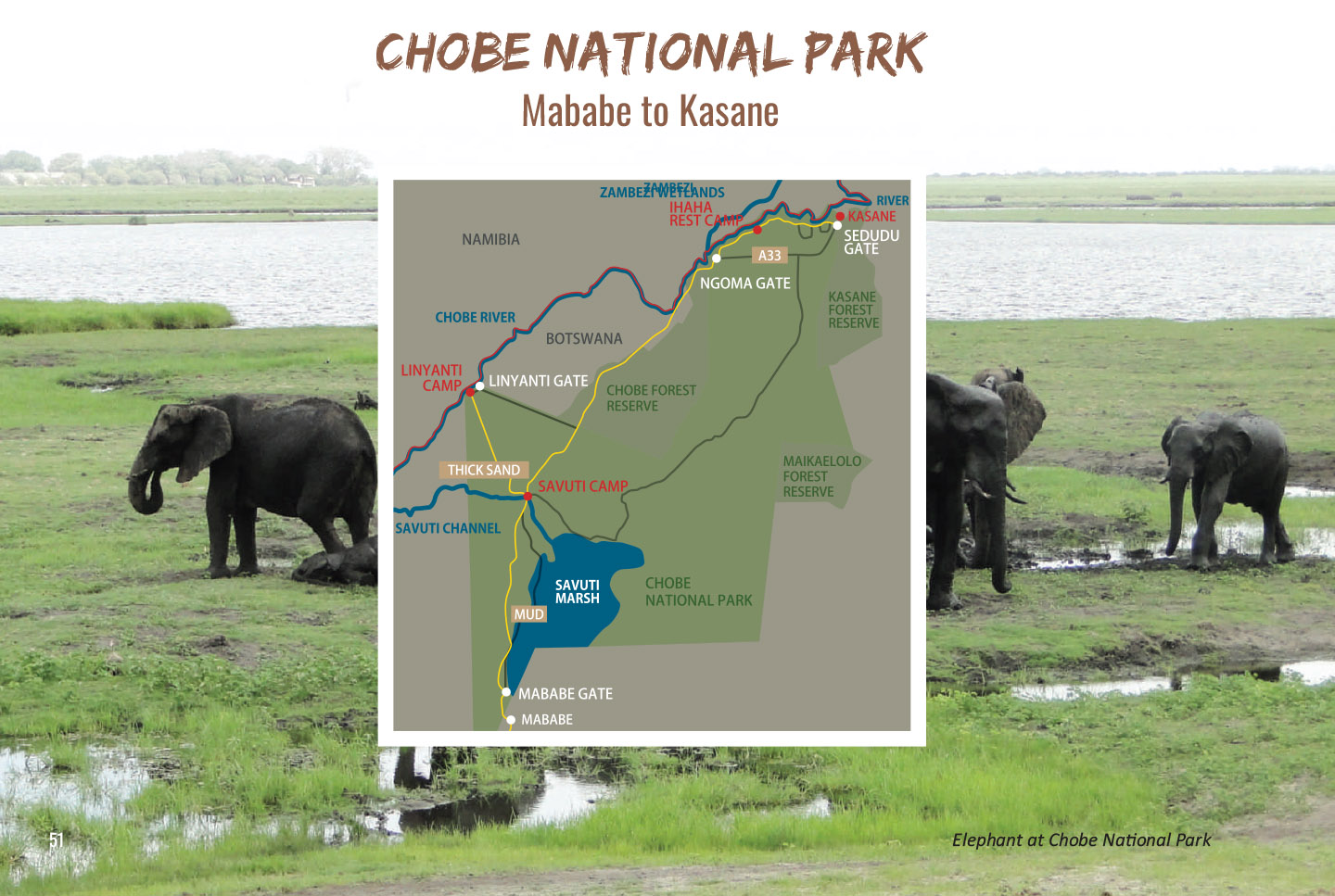Mababe To Kasane.
Bordered by the Chobe River to the north and home to a large marshland fed by the Savu Channel, Chobe National Park is where you’ll find one of the largest concentrations of wildlife in southern Africa. Access to the park is 4×4 only and while it’s large ‒ covering nearly 12 000km2 in total ‒ the networks of tracks available for game viewing are focused around three main regions: Savuti, Linyan, and the Chobe Riverfront.
At the southernmost p of the park is Mababe Gate, the only point of entry for anyone traveling to Chobe from the south. From Mababe Gate, it’s 65km along Sand Ridge Road to the nearest of the park’s three public campsites, Savu Camp. It’s a tough slog along deep sand tracks, and the drive takes 3 to 4 hours. The track carves its way up the park on the eastern side of the Magwikhwe sand ridge and the western side of Savu Marsh ‒ one of Botswana’s famed wildlife regions, fed by Savu Channel, which drains the Okavango erratically and seemingly independently of rainfall.
Traveling northwards, a deeply rutted mud track (Marsh Road) peels off to the right about 500m from Mababe Gate. This goes all the way to Savu Camp, skirting the southern section of the marsh and rejoining the main track in places. The southern sec on of this road can become very muddy and it’s best avoided when making the initial drive north. Even when dry, the deep ruts make the road slow going, and there’s a good chance of getting stuck and delaying your arrival at camp. So it’s best to stay on Sand Ridge Road for the first 50km at least, after which, several side tracks finger their way out towards the marsh and surrounding pans.
Savuti Region
The Savu region spans the southwestern sec on of Chobe National Park and comprises woodland, open plains, and wetlands. It’s legendary for game viewing and it’s home to lion prides that have been known to take on big game such as buffalo. There are several Jeep tracks that wind their way through this region.
The most popular is the section just south of Savuti Camp. Here, sand tracks follow the seasonal Savuti Channel, which drains into the vast marshland. When dry, large sections of the riverbed are navigable (keep to the tracks on either side) and following the channel south to one of the many waterholes and pans – some natural, some manmade – is a good day’s game viewing.
There are 14 campsites with braai facilities and elephant-proof ablutions with showers and flushing toilets. The best campsites are the 5 large sandy spots on the northern part of the outer ring that looks onto the Savufi Channel. R5V1 (nicknamed Paradise) is prime.
Linyanti Region
40km north of Savuti, along a sand road that takes about 4 hours, is Linyanti. Deep sand patches that stretch for up to 1km at a time start 5km from Savuti. From there, the track alternates between these so patches, firmer gravel sections, and several low depressions with high, chassis-scraping ridges in the center. Most have alternative loops around them. There’s just a handful of tracks in the Linyan region, two of which run along the edge of the Linyan River, between the campsite and Linyan Gate 5km northeast. Guests staying at Linyan are required to check-in at the gate first. There are five campsites, all with views over the river. There are braai facilities and shared ablutions. Sites aren’t clearly demarcated so look out for markers pinned to trees.
CHOBE RIVERFRONT
Along the northern part of Chobe, parallel to the tar A33 transit road that joins Ngoma Gate to Sedudu Gate and continues to Kasane is a 50km loop that runs along the Chobe River. It’s a worthwhile detour, time permitting, but visitors are advised to call ahead (+267-625-1772) to ensure that the route is open.
Certain sections of it have been closed to self-drivers in the past and seasonal flooding can also
force closure of the track closest to the river.
Camping is at lhaha Rest Camp. There are 10 sites with basic ablutions. These overlook a hippo pool in the dry season, while in the high-water season, the river is in full flow below the campsite.
PIT STOPS
Kasane ATM, shops, bottle store, fuel, tyre repair, mechanic, DWNP offices.
ROAD CONDITIONS
Thick sand in most places and tire-sucking mud after rains, especially near the marsh. The road from Savuti to Ngoma Gate is graded gravel. The A33 transit road is tar.
PARK GATES
Linyanti, Mababe, Ngoma, and Sedudu Gates are all open 6 am to 6.30 pm from May to September and 5.30 am to 7 pm from October to April.
WHERE TO STAY
SKL Group operates Savuti and Linyati camps www.sklcamps.com.
Kwalate Safaris operate Ihaha Camp. See website for park and vehicle fees www.kwalatesafaris.com.
TIP
The flow of water in the Savuti Channel is erratic and not driven by rains, but by tectonic activity. Call the South Camp Gate to check conditions at +267-7620-0218

